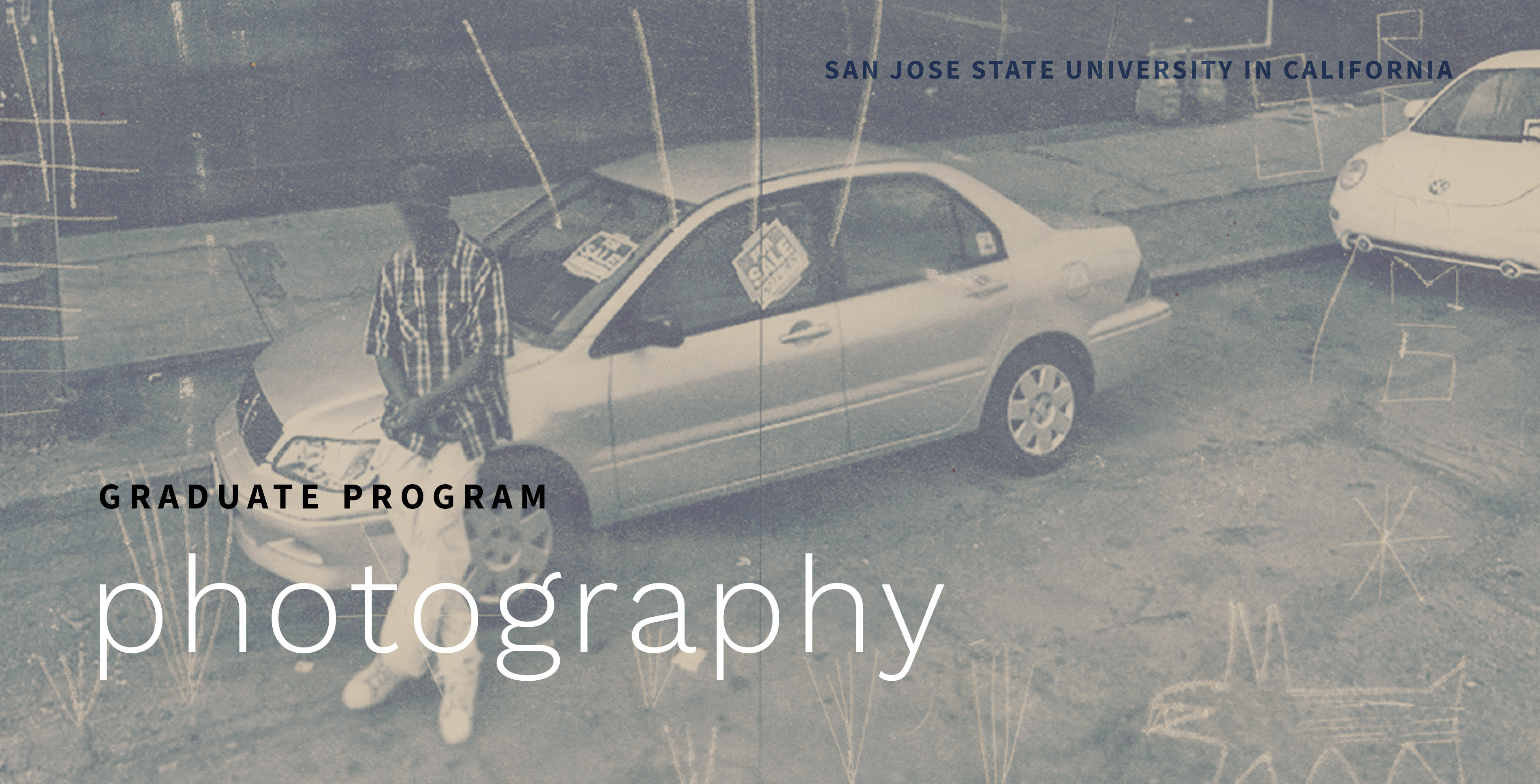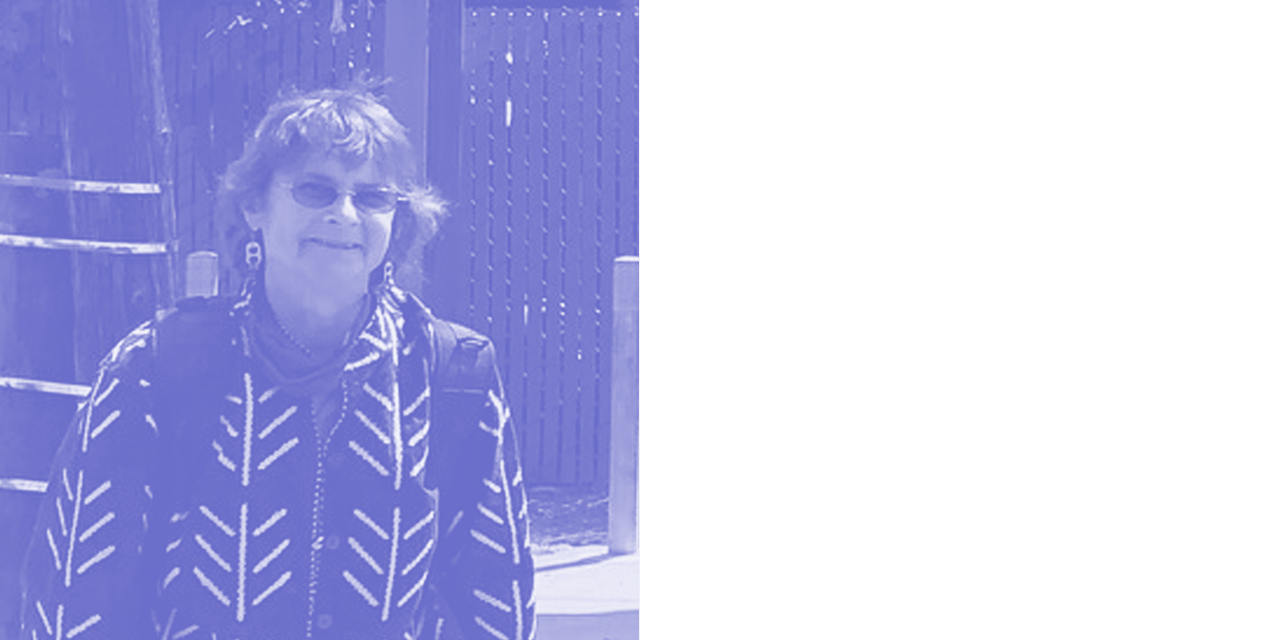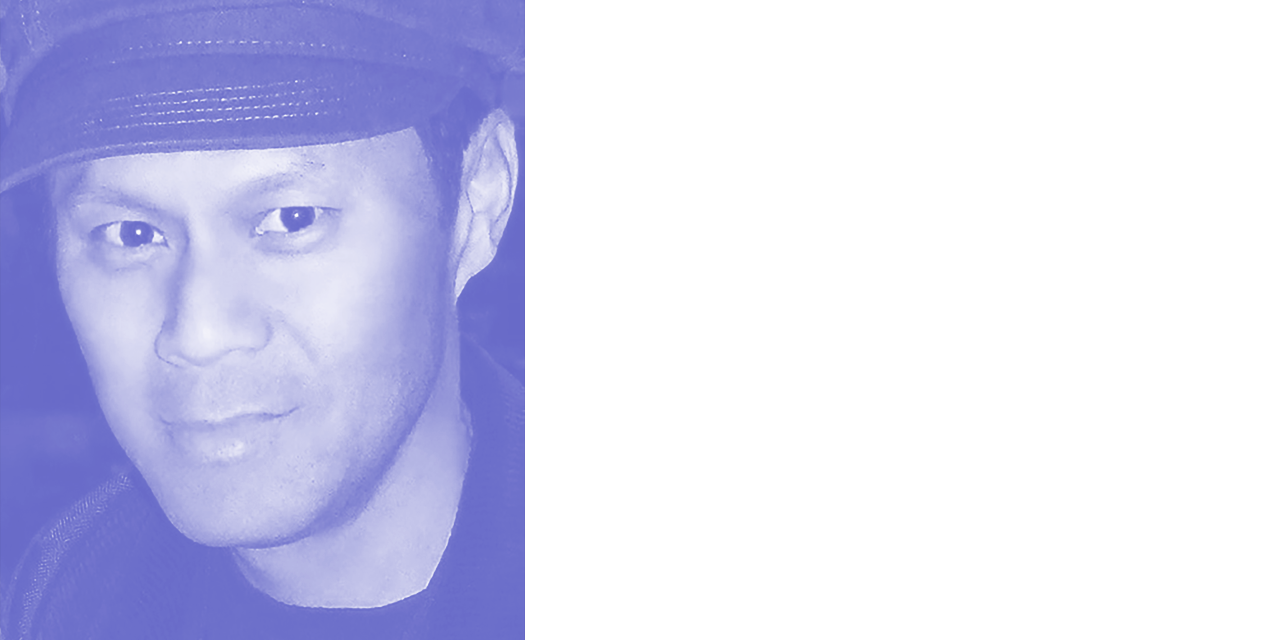Photography
On this page:
- Degrees Offered
- Undergraduate Program
- BFA Art Concentration in Photography
- Minor Photography
- Graduate Program
- MFA Art Concentration in Photography
- Undergraduate Program
- Facilities
- Faculty & Lecturers
Undergraduate Program
Degrees: BFA Art Concentration in Photography | Minor Photography
Over the past 30 years, our nationally recognized program has earned a well-deserved
reputation as one of the most comprehensive photography programs on the West Coast.
Located within the School of Art & Design, the Photography Program at San José State
University is the largest in the California State University system and one of the
largest in the Western United States. Our curriculum engages students in a diverse
range of contemporary practices in the medium, from traditional silver-based photography
and historic, alternative photo processes to innovative and experimental approaches
to digital imaging and video.
In addition to our emphasis in photography as a fine art, our program also offers a strong commercial photography pathway, a feature that makes our undergraduate program unique. Covering a full spectrum of technical, aesthetic, conceptual, and theoretical issues, one of the primary objectives of the Photography program is to enhance the student's ability to conceptualize complex ideas that are expressed visually.
Throughout its history, photography has served as a powerful means of self-expression, a catalyst for cultural change and a medium for social commentary and activism. We encourage students to produce thoughtful artwork that deals with the meaningful and urgent issues of our times. We also recognize the increasing interdisciplinary nature of photography, and encourage interested students to explore and integrate related media including installation, film and video, and electronic media
Quick Links
Program Learning Outcomes (PLO)
PLO 1
Analyze and research visual and conceptual problems and both apply and explain their use of basic design principles, concepts, tools, techniques, media, materials, formats, and visual languages to solve those problems. We expect our students to bring their expertise in finding visual-verbal solutions to problems as they embark on a lifetime of self- and professional employment in a variety of careers. As students they will demonstrate their development and application of art knowledge in a wide range of studio courses, culminating in a capstone course.
PLO 2
Demonstrate increasing skills in the use of diverse materials, tools, and media, and be able to explain and evaluate success/failure in individual and group critiques. We expect our graduates to be lifelong problem-identifiers and problem solvers, always on the lookout for new and better skills. Prior to graduation, they will demonstrate their making/evaluating skills in studio courses and their skills of self-assessment and explanation in a sequence of interdisciplinary professional courses and in a capstone course.
PLO 3
Demonstrate their commitment to valuing art’s role in offering cultural critique and addressing issues of social responsibility in a global society. As creative professionals, our graduates will, we hope, assume leadership roles in engaging with social and cultural change-as teachers, as critics, as spokespersons for important issues that cannot yet be imagined. As undergraduates, our students will demonstrate their understanding of the values of contemporary art in their visual and written responses to class assignments in studio courses and in the interdisciplinary core and capstone courses (where these qualities will be assessed), in their work on collaborative group projects, in the successful articulation of their ideas in exhibitions and artist statements.
PLO 4
Apply their knowledge of visual history and theory to their creative endeavors and to their professional practice. They will be able to speak and write clearly about art and global culture, using appropriate terminology and demonstrating their understanding of the contemporary art world. They will demonstrate their ability to place their own work within the broader context of historical and contemporary art and ideas. Our graduates will commit to continued personal engagement with intellectual issues in contemporary art and culture. As students, they will demonstrate their understanding of visual history and theory in assignments completed for their art history courses and their understanding of the intellectual context and historical precedents of their own work in assignments completed for their professional core and capstone courses.
PLO 5
Demonstrate their readiness for careers as creative professionals by completing a more sequenced and specialized course of study in sculpture, installation and other three-dimensional art forms. Admission to the BFA requires students to demonstrate their ability to work independently as artists. Students will have successfully developed and presented for review by the Department’s faculty (a) a unified body of work (10 images), (b) n artist statement (of purpose) and then secured (c) support and commitment of two area faculty members willing to serve on that student’s BFA committee. Each BFA candidate then (d) successfully completes the professional BFA seminar and (e) schedules and mounts in one of the Department’s student exhibition galleries a solo exhibition (as the work for ART 199) that meets the approval of the student’s BFA committee. Our BFA graduates will embark on professional careers as practicing artists and creative professionals and/or apply to MFA programs for further instruction and certification for college/university teaching.

Graduate Program – MFA
MFA Art Concentration in Photography
Our Photography Graduate Program supports and encourages a wide range of traditional, conceptual and interdisciplinary approaches to lens related imaging. Philosophically, the program is committed to addressing the breadth of contemporary issues and practices while realistically preparing you for a career in the field. The faculty is composed of artists/photographers with national and international careers whose work ranges from conceptual installation and new genres to traditional and commercial. There is no pervasive aesthetic trend at SJSU; the faculty has been carefully selected to offer a wide range of aesthetic and technical possibilities to the students. Our program welcomes and promotes diverse styles and viewpoints. We encourage students to produce thoughtful artwork that deals with meaningful issues, and our faculty is here to help you refine your direction and create your best work.
Teaching Opportunities
During the course of their studies in the program, qualified graduate students may apply for the opportunity to teach at the Teaching Associate level, which provides a generous stipend and tuition waiver. Students are offered considerable freedom between teaching, studio practice, academic classes and outside internships within which to design a program specific to their individual needs.
Quick Links
- Application Instructions and Procedures
- Degree Requirements: MFA Photography
- Academic Summary Form [pdf]
- MFA Summary
Program Learning Outcomes (PLO)
PLO1
Will be able to analyze and research visual and conceptual problems and both apply and explain their sophisticated use of the elements and principles of art to solve those problems. Our graduates will be artists capable of studio practice and exhibition at the professional level.
PLO2
Will be able to demonstrate increased technical capabilities and skills relevant to their areas of expertise and be able to explain and evaluate success/failure in individual and group critiques. We expect our graduates to be lifelong problem-identifiers and problem-solvers, always on the lookout for new and better skills. Prior to participation in a final thesis exhibition, MFA candidates will already have demonstrated their skills in portfolio reviews, frequent faculty and peer critiques, evaluations by thesis committee members, and in solo and group exhibitions.
PLO3
Will demonstrate their commitment to valuing art’s role in offering cultural critique and addressing issues of social responsibility in a global society. As creative professionals, our graduates will, we hope, assume leadership roles in engaging with social and cultural change--as teachers, as critics, as spokespersons for important issues which cannot yet be imagined. As graduate students, our MFA candidates will demonstrate their understanding of the values of contemporary art in their visual and written responses to class assignments in area and interdisciplinary seminars and in the successful articulation of their ideas in exhibitions and artist statements.
PLO4
Will apply their knowledge of visual history and theory to their creative endeavors and to their professional practice. They will be able to speak and write clearly about art and global culture and demonstrate their understanding of the contemporary and global art world. They will demonstrate their ability to place their own work within the broader context of historical and contemporary art and theory. Our graduates will commit to continued personal engagement with intellectual issues in contemporary art and culture.
PLO5
Will not only be capable of studio practice and exhibition at the professional level but also will have demonstrated the ability to organize and present technical and intellectual information and to lecture/teach on a variety of topics in photography. Those students who seek teaching positions while still in graduate school will be mentored in classroom assistant capacity for two semesters, carefully screened for a teaching pool, trained as teachers, and carefully evaluated when hired as Teaching Associates. We expect our graduates to be experienced and professional teachers.
Facilities
The Photography Program's technical facilities are among the best and largest in the
West and include Six Epson printers (4880, 4900, 7880), a Canon large format printer,
a large complement of digital support equipment, digital and film based cameras, and
four instructional complexes with fifty enlargers, eight commercial lighting studio
stations, and facilities for alternative photographic processes. We recognize the
future of most photographic practice to be digital, yet we honor and respect the educational
value and the potential for self-expression available in traditional darkroom facilities.
To that end, we maintain traditional darkrooms and an alternative processes lab, while
we continue to upgrade our digital equipment as the technology advances.
Program Coordinator:
Prof. Binh Danh – binh.danh@sjsu.edu
Graduate Contact:
Prof. Rhonda Holberton – rhonda.holberton@sjsu.edu
Faculty & Lecturers

Binh Danh
Assistant Professor
Area Coordinator - Photography
Duncan Hall 401C | binh.danh@sjsu.edu
Binh Danh is an Assistant Professor of Art at San José State University’s Photography Program. He received an MFA from Stanford and a BFA from San Jose State University and had emerged as an artist of national importance with work that investigates his Vietnamese heritage and our collective memory of war. Danh produces socially engaged work that often involved community outreach and archival research that deals with mortality, memory, history, landscape, justice, evidence, and spirituality.
He invented the chlorophyll printing process, in which photographic images of the Vietnam War appear embedded in leaves through the action of photosynthesis. Another body of work, “War Memoranda: Photography, Walt Whitman, and Memorials” grows out of an ongoing eight-year collaboration between Binh Danh and poet Robert Schultz. Currently, a traveling exhibition, War Memoranda examines the question “How do Americans remember war?” The artist and poet have used soldiers’ photographic portraits developed onto the flesh of leaves, historical battlefield landscapes photographed using 19th-century technologies and poems about war to provide intimate reflections on the after-effects of war. Danh’s newer body of work focuses on nineteenth-century photographic processes, applying them in an investigation of battlefield landscapes and contemporary memorials. Recent series of daguerreotypes celebrated the United States National Park system during its anniversary year, commemorated a makeshift soldier memorial for the was in Iraq/Afghanistan called the “Crosses of Lafayette,” and documented humankind attempts to make marks in the land through daguerreotypes of Spiral Jetty and petroglyphs in the Southwest.

Robin Lasser
Professor
Duncan Hall 401A | robin.lasser@sjsu.edu
Robin Lasser is a Professor of Art and former Coordinator of the Photography Program at San José State University. Lasser is also the project lead for the Seven Days-Sister City-Artist Exchange. She lives in Oakland, California with her husband Jim Gold and son Alex Lasser-Gold. Lasser produces photographs, video, sound, site-specific installations, and public art, which explore environmental, health, cultural and social issues, especially as they pertain to women. Lasser often works in collaboration with other artists, students, public agencies, and international coalitions to produce art and promote public dialogue. The creative team of Robin Lasser + Adrienne Pao have developed and managed the Dress Tents project since 2004.
Robin Lasser’s recent national and international showings include Exit Art and Parsons School of Design in New York City; Kohler Arts Center in Sheboygan; Los Angeles County Museum of Art in Los Angeles; De Young Museum in San Francisco; Dom Metenkova Museum of Photography in Yekaterinburg, Russia; Recoleta Cultural Center in Buenos Aires, Argentina; Caixa Cultural Center in Rio De Janeiro, Brazil; Nuit Blanche Festival, Toronto, Canada; Pingyao International Photo Festival in China; and the ZER01 International Biennial in San José, California. Robin Lasser’s Dress Tents and public art were featured in art, fashion, architecture, and pop culture magazines around the world including Happy (Russia 2011), COLOR(International 2011), Vision (China 2011), Top (Brazil 2009), Dazed and Confused (London 2008), Amica(Bulgaria 2007), Marie Claire (Taiwan 2007) CRAFT (United States 2007), Flaunt (International 2006), Playboy (South America 2006), and many others.

Valerie Mendoza
Associate Professor
Duncan Hall 401C | valerie.mendoza@sjsu.edu
Valerie Mendoza is a lens-based installation artist, writer and educator. Her work mines the intersections between history, memory, media, cultural institutions, and language. Using photographs, video, audio, objects, various forms of information, and personal narrative, her work creates a cross-disciplinary dialogue between disparate sources.
Research for her video series, Consumption, took her to Spain, France and Belgium in the early 2000’s. She worked as part of an archeological team focused on Neanderthal belongings and remains in 2002 for her video/installation division. From 2005 to 2006, she worked at the border of the U.S. and Mexico shooting footage for her video/installation Different, naturally. In fall of 2010, she began a new body of work addressing the national housing crisis. As one of 8 artists in residence at Camac Centre D’Art, Marnay Art Centre, France in December, 2010, she began work on her photo-based installation Monument: 91 Images of One Vacant Property for Sale. A preliminary version of her companion installation entitled Our Agentswas completed in 2016. Over summer 2016, she spent four weeks in Portugal during a Caminho português de Santiago, taking over 2000 photographs studying perceptions of land use both similar to, and different from those in the U.S. In fall of 2017 she was one of 5 artists in residence at DE LICEIRAS 18, Porto, Portugal, where she extended her research addressing the issue of housing on an international level. A solo exhibition, O Custo de Vida(The Cost of Living) was featured in November 2018 at Galeria do Sol in Porto, Portugal.
Mendoza’s work has been exhibited in France, Ireland, Mexico, Portugal, and venues throughout the United States. Her practice is based in the San Francisco Bay Area where she is an Associate Professor at San José State University.

Kathleen McDonald
Facility Coordinator
Lecturer
Kathleen McDonald is a West Indian multidisciplinary artist who creates installations in the themes of identity, culture, memory, and immigration. McDonald’s work uses aspects of the Caribbean including flora, mythology, and poetry to touch on mother/daughter relationships, question one’s relationship to place and past and reclaim lost histories. McDonald is trained in a variety of textile techniques, photography, printmaking, painting and metal fabrication and casting which are often used in their work.
McDonald received dual BFA degrees in Pictorial Art and Photography, and holds a Master of Fine Arts from San Jose State University. They have worked for non-profit and small art organizations educating and inspiring creativity in youth of varying ages. Since 2014, McDonald has taught at a number of higher education institutions in the Bay Area such as West Valley College, and Academy of Art University, to name a couple. Currently, McDonald is the Photography Facility Coordinator at San Jose State University where they also teach photography courses.

Alana Rios
Lecturer
Alana Rios is a photo-based artist using historical and contemporary processes to explore the relationship between landscape images, gender, and power. Her recent exhibition Postpicturesque includes three bodies of work, Superbloom & Cut Flowers, The Calendar Project, and Vista Points: Overview & Time-Lapse.
Her work has been exhibited at Sylvan Gallery, Root Division, Embark Gallery, and Joshua Tree National Park Council for the Arts. In November 2019, she co-moderated a panel discussion at the SPE West Regional Conference titled, A Feminist View of the Landscape: An Intimate, Political and Emotional Relationship to the Land. She earned a BA in photography and printmaking from Bennington College in VT and an MFA in photography from San José State University. She is currently a lecturer in photography at San José State University and resides in Oakland, CA.

Jonathan Fung
Lecturer
Duncan Hall 401D | jonathan.fung@sjsu.edu
Jonathan Fung is an interdisciplinary artist, filmmaker, social activist, and educator. Fung teaches photography and art at San Jose State University through a social justice and narrative lens. He began his career shooting fashion editorial in New York, Paris, Milan, Los Angeles, and San Francisco.
Fung expanded his art practice from still photography to moving images and collaborated with Nam June Paik (the “Father of Video Art”) for Modulation in Sync at the Guggenheim Museum and Electronic Superhighway at the Holly Solomon Gallery in New York City. His lens-based work was on view at the Venice Biennale in the Snow Show exhibition. Fung was a participant at the Doek Festival where his film Een Nauwe Poort (A Narrow Gate) was screened in the canals in the Netherlands onto 17th century ship sails. Fung’s disconcerting video installation, I Eat, Therefore I Am, was exhibited at the San Jose Museum of Art.
For the past 13 years, Fung’s work has been a platform to expose the darkness of human trafficking and spread awareness. His award-winning short film Hark was screened at many film festivals, including the Cannes Film Festival Court Metrage. Fung’s public art installation PEEP was invited into the 5×5 Project in Washington DC. A year later Fung was commissioned by the San Jose Art Commission to recreate PEEP in downtown San Jose as part of Super Bowl 50 festivities.
Jonathan Fung served as a Faculty Fellow for the MOSAIC Cross Cultural Center that raises awareness for social justice and diversity. He was part of the Trauma Informed Pedagogy, Faculty Learning Community and later received a first aid mental health certification so he could better serve his students.
